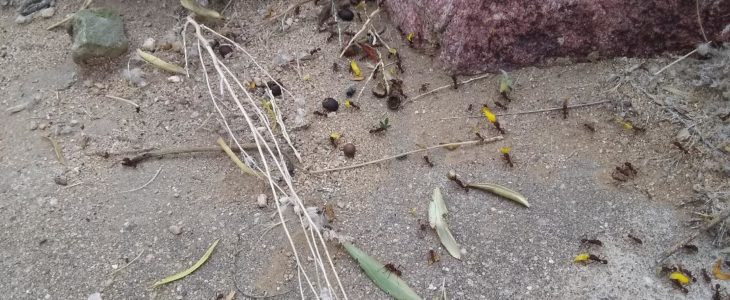
Happy Fall! As the Aesop’s fable goes, the ants spent the fall working hard to prepare for winter. The grasshopper played and sang, then went hungry. In Tucson, fall is both a busy growing season requiring work in the garden, and an inviting time to play outside. Let’s explore!
The industriousness of ants has caught our family’s attention for real this fall. While the kids played in the front yard before school last week, they noticed a yellow stripe across the road. Leaves, flowers, and seeds from our creosotebush! Some plant parts were in motion, carried boldly by leafcutter ants. Some had been abandoned, as ants learned their own strength by trial and error. Both the parade and the route impressed us. Together, the kids and I followed out of curiosity. 
Across the street, ants climbed a steep rock – and sometimes toppled down. My boys got a kick out of that, though kindly didn’t instigate any toppling. Ants tried multiple paths into the neighbor’s rocky slope – some with plant parts, some without. The diversity of harvest increased – some ants picked up spherical seeds from the neighbor’s palm tree, and some ants then rolled down the rock with their find. And they kept marching to their nest further into the rocks. 
Why did the ants cross the road? According to a children’s reference book back at home, they were toting materials to make a nutritious fungus farm down inside their nest. Meanwhile, my kids were getting restless, plus it was time to go to school. I’m grateful to the leafcutter ants for lessons of perseverance, learning ones’ own strength, and beauty that captivated even my rambunctious children. “The ants made the road glittery,” remembered Kid 3 happily days later, after the ants were gone.
At a Cub Scout campout at Catalina State Park this weekend, the ants’ work was more interrupted. One group of scouts made ant houses with a construction kit, then had a good time finding and temporarily collecting wild ants. The structured kids’ activity led to loose and mostly-harmless exploration of ant behavior. Kids blend work and play throughout their day.
What about the grasshoppers? Do they deserve the reputation of playing frivolously? I decided to look. Right away, I found a fat grasshopper on a half-eaten leaf at the school where I work. That same citrus tree had a fat swallowtail caterpillar the week before. So I can’t say for certain the grasshopper got the credit for eating, but neither was it playing.
A couple days later, one of my Miles ELC students pointed out a “torn” corn leaf in their garden bed. The class swarmed over and quickly spotted the culprit: another grasshopper, on the edge of that leaf and below two other mostly-missing leaves on the same plant. It didn’t want to leave! A dozen kinder-through-second-graders gawked, crowded, and poked. The grasshopper stopped eating but worked at keeping its feast. It scooted over to the stem and held on tight, only leaping after someone finally tried to grab it. Student shrieks and jumps ensued, as well as a brief discussion about the overall health of the plants despite the lone feeding grasshopper.
My boys often find grasshoppers down in the weedy gravel of our backyard or the broad field of their school playground. And they play with them. The surprising jumps out of camouflage, the lack of threat of being bitten, and the thrill of trying to catch an animal in motion – grasshoppers are fun for people. Perhaps that lines up with the fable? Here in temperate-wintered Arizona, however, I have no worries for the grasshoppers finding food later even if they engage in play now.
Carving out time to play is not easy for me as either a parent or teacher, though moments of discovery are a form of fun. What do work and play look like in your yard, playground, or garden? What insects are you and your kids finding this fall? Enjoy the current combination of cool mornings and warm afternoons!
Would you like help attracting, managing, or understanding the insects in your own backyard? Schedule a private or group “What’s a Bug” lesson with Nature to You HERE.

